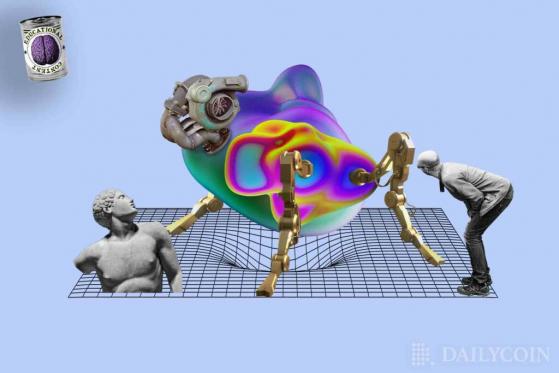What it means and how it differs from original NFT technology from DailyCoin

 NFT 2.0 explained: what it means and how it differs from original NFT technology
NFT 2.0 explained: what it means and how it differs from original NFT technologyThe Non-Fungible Token or NFT market has long been criticized for its bubble-like nature, and while this is a sad reality, the root cause can be attributed to various factors. In particular, there is a general misconception that technology is profit-oriented rather than use-oriented, combined with early users’ endless desire to get rich quick.
For example, the majority of early users believe that NFTs have little or limited use beyond tokenization (ie embossing) JPEGs and auctioning them for monstrous amounts, or let’s say that is what most people believe. Indeed, this seems to be the case with the earliest iteration of NFT technology, although this is about to change completely with the use of NFT 2.0.
NFT 2.0 is essentially an upgraded iteration or evolution of NFT technology and as such introduces new updates while integrating more utility into the existing NFT infrastructure.
But before we delve deeper into the NFT 2.0 world, it’s just as important to familiarize yourself with the initial NFT 1.0 iteration, especially as one who is brand new to the NFT world. That said, what are the features of NFT 1.0?
Understand the origins of NFT technology
NFT 1.0, which is the origin of NFT technology, refers to cryptographic assets stored on a blockchain using unique identification metadata that distinguishes each other.
In other words, the first iteration of NFT is more about tokenizing digital assets so that they are made unique and can be stored on a blockchain network where they become immutable, verifiable and cryptographically secured.
In essence, NFT 1.0 paved the way for ownership of digital assets, while enabling what we now understand to be the creators’ finances. This further supports the common generalization that genesis NFT iteration is more focused on the commercialization of tokenized objects, and therefore justifies the misconception among early users who are perceived as more profit-oriented.
However, the current hype associated with most NFT projects as well as the general misconception has paved the way for the new NFT 2.0 iteration, which on the other hand is more utility driven. That said, let’s find out what’s special about the new NFT iteration and what it means for the creators’ finances in general.
Understand NFT 2.0
To begin with, NFT 2.0 is not completely different from NFT 1.0. In fact, the latter can not operate independently of the former, and to be more precise, NFT 2.0 simply builds new capabilities into the existing NFT infrastructure.
Putting the above in context, while NFT 1.0 enables ownership and commercialization of tokenized digital objects, NFT 2.0 expands the possibilities by creating new digital asset markets with advanced tools (ie use cases).
Especially the latest NFT iteration allows NFT holders to do more with their tokenized assets, which can be anything from unique digital artwork to in-game items, coupons / tickets, music and essays, among other digital collectibles.
So what’s different about this iteration? You can ask. NFT 2.0 has essentially four main features, including “generativity”, “composability”, “interactivity” and “experimentalism” that set it apart from its predecessor. Since each serves unique purposes, let’s take a closer look at these characteristics;
Composition / upgradeability
This special feature allows collectors to get creative and explore new possibilities by combining different assets as one. Keep in mind that these secondary assets are not limited to other non-fungible tokens, but they can also be fungible assets such as cryptocurrencies.
In other words, NFT holders can expand the usefulness of their existing NFT by embedding more digital assets. In this way, unlike in its original state, the NFT element will be able to serve several purposes, thus creating a tailored NFT package.
Let’s put this into a more relatable context by using an artist as a case study. As an artist, your NFT artwork can function as more than just a work of art. It can serve as a medium for distributing social tokens for example. For example, in addition to selling this artwork for monetary value, people who have such assets can also access other exclusive benefits.
A prominent example of a platform that makes NFTs better by using composability is KnownOrigin, which is a platform where NFT holders can build new benefits into their existing digital assets.
Interactivity / Dynamism
With composability attributes, the latest NFT iteration allows tokenized digital elements to evolve from their original state. However, “dynamics”, which can otherwise be described as interactivity, allow existing NFTs to self-modify them and other NFTs associated with it.
Essentially, by equipping each NFT with smart contracts, they literally become “smart” and “intelligent” so that they can take input from users as well as other qualified sources. The introduction of smart contracts for existing NFT infrastructure also makes it possible to connect and modify existing NFTs in the first place.
Depending on input from external sources, the latest NFT iteration also enables users to modify their tokenized objects from their existing state to suit current needs or purposes, especially when used across different categories of decentralized applications, including GameFi projects, Metaverse, IP patenting, Tickets and much more.
Generativity
Another important feature of NFT 2.0 is its ability to create algorithmic randomness in tokenized digital assets. To understand how generativity works in NFT, let’s paint a scenario.
Let’s say you have three devices: an iPod that only supports text and music, an iPad that supports video, and a photo book that only supports photos.
Remember that NFT 2.0 allows you to combine many assets (in this case content) into a single device. As a result, an NFT uses AI-driven algorithmic randomness to select which one is appropriate for each device when sent to or retrieved by that device.
Therefore, if you access an NFT with an iPod, for example, only the audio will play, while other devices will play video, music, and photos, respectively.
Experience
Essentially, the three mentioned properties constitute the experiential property of NFT 2.0 in the sense that together they make it possible to capture a real user experience. This also means that in addition to the commercialization of a tokenized digital asset, a holder can further explore other use cases for an NFT in his daily lifestyle.
For example, NFT is now widely used in the ticketing industry, enabling holders to enjoy the true definition of exclusivity when attending events physically or virtually. Not only that, NFT is used across various industries, including entertainment, film and video distribution, automobiles and many more.
That said, other key features of NFT 2.0 include co-ownership of NFT articles; here, unlike NFT 1.0, which enabled sole ownership, multiple people can come together to acquire a single NFT. This feature allows collectors to divide ownership of items as well as sell them in parts.
Ultimately, NFT 2.0 opens up new opportunities and expands the usefulness of NFTs for individuals and organizations. While each NFT 2.0 feature enables new uses, their combined potential offers endless possibilities.
Continue reading on DailyCoin

























